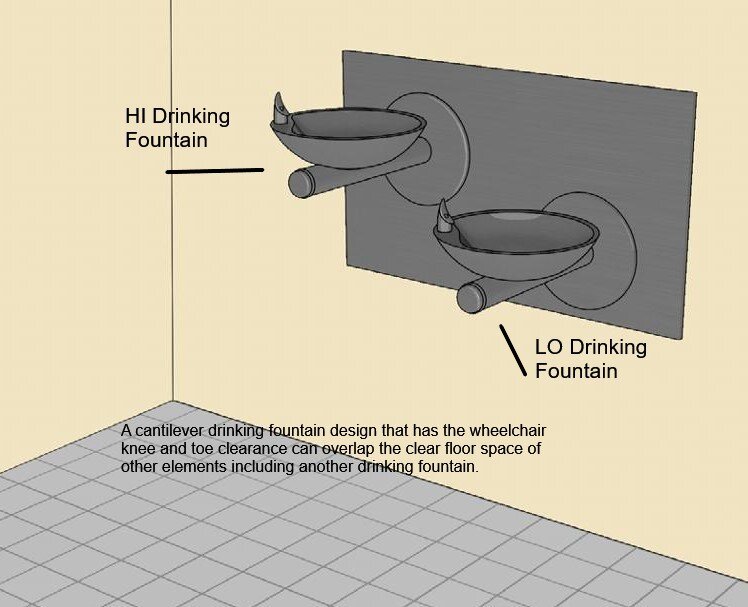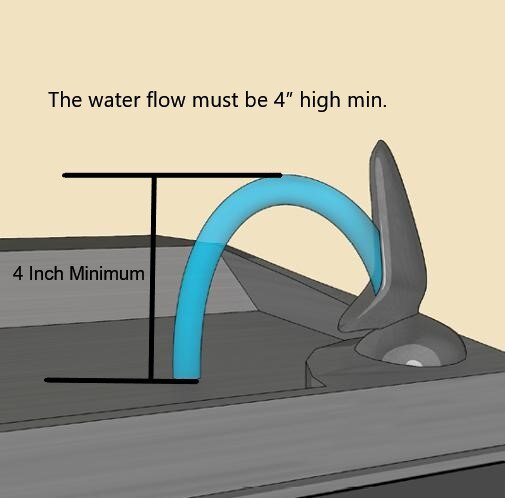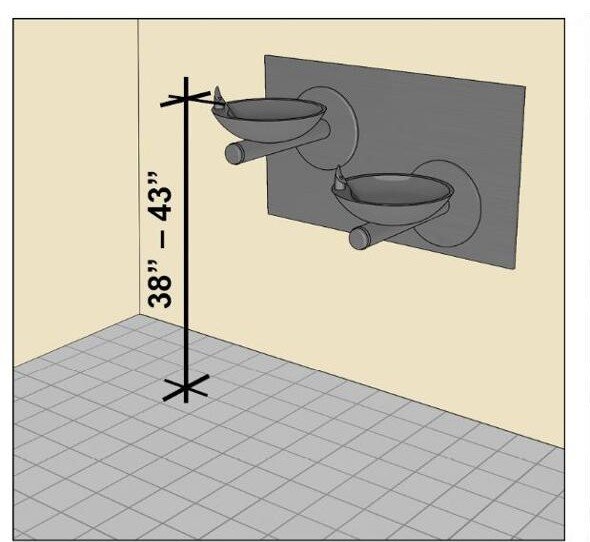Drinking Fountains and the ADA
Accessible Drinking Fountains
Accessible drinking fountains in Title II and Title III facilities are required to comply with the Americans with Disabilities Act (ADA). The sections of the 2010 ADA Standards that cover requirements for drinking fountains include 202.4, 211, 602, §35.151 New construction and alterations (Title II), and §36.403 Alterations: Path of travel (Title III). This article will discuss the ADA scoping and technical requirements for drinking fountains in State and local government facilities, public accommodations, and commercial facilities. The photo on the right is representative of drinking fountains in a place of public accommodations.
Scoping Requirements for Drinking Fountain Installations
2010 ADA Standard 202.4, Alterations Affecting Primary Function Areas, states, “In addition to the requirements of [Standard] 202.3, an alteration that affects or could affect the usability of or access to an area containing a primary function shall be made so as to ensure that, to the maximum extent feasible, the path of travel to the altered area, including the rest rooms, telephones, and drinking fountains serving the altered area, are readily accessible to and usable by individuals with disabilities, unless such alterations are disproportionate to the overall alterations in terms of cost and scope as determined under criteria established by the Attorney General.”
In other words, if an area of primary function is altered, any drinking fountain along the route to the primary function area from the site arrival points must be ADA accessible, in most cases. An area of a building or facility containing a major activity for which the building or facility is intended is a primary function area. The graphic below is representative of this Standard. Note the water fountain.
Accessible Route and Drinking Fountain to Primary Function Area
Similar wording regarding drinking fountains and alterations of primary function areas can be found in 2010 ADA Standard sections §35.151 New construction and alterations (Title II), and §36.403 Alterations: Path of travel (Title III).
2010 ADA Standard 211 covers scoping requirements for drinking fountains.
2010 ADA Standard 211.1, [Drinking Fountains] General, states, “Where drinking fountains are provided on an exterior site, on a floor, or within a secured area they shall be provided in accordance with [Standard] 211.” The term secured area is intended to apply to any space where entry is restricted or controlled.
In other words, if a facility has drinking fountains outside or inside the facility, including secured areas, then some of the drinking fountains have to be ADA accessible. This is true for new construction and existing facilities that are altered. An exception to this Standard is in detention or correctional facilities, where drinking fountains that only serve holding or housing cells not required to comply with [Standard] 232 are also not required to comply with [Standard] 211.
2010 ADA Standard 211.2, [Drinking Fountains] Minimum Number, states, “No fewer than two drinking fountains shall be provided. One drinking fountain shall comply with [Standards] 602.1 through 602.6 [LO/sitting] and one drinking fountain shall comply with [Standard] 602.7 [HI/standing].” This HI/LO installation will be explained below in Standard 602.
The exception for this Standard is where a single drinking fountain complies with [Standards] 602.1 through 602.6 and 602.7, it shall be permitted to be substituted for two separate drinking fountains.
In other words, in a facility where drinking fountains are installed, this dual access (HI/LO) must be provided on each floor of a facility equipped with drinking fountains, as well as an exterior site, and each secured area of a building where drinking fountains are provided.
2010 ADA Standard 211.3, [Drinking Fountains] More Than Minimum Number, states, “Where more than the minimum number of drinking fountains specified in [Standard] 211.2 are provided, 50 percent of the total number of drinking fountains provided shall comply with [Standard] 602.1 through [Standard] 602.6, and 50 percent of the total number of drinking fountains provided shall comply with [Standard] 602.7.” The exception for this Standard is where 50 percent of the drinking fountains yields a fraction, 50 percent shall be permitted to be rounded up or down provided that the total number of drinking fountains complying with [Standard] 211 equals 100 percent of drinking fountains.
In other words, if there are more than two drinking fountains, then at least 50% of the total have to be ADA compliant. For example, if there are 5 total fountains on the first floor of a building, and 2 are lower units for individuals using a wheelchair, and 3 are for individuals standing, then at least 1 of the low drinking fountains must be accessible, and 2 of the drinking fountains for standees must be accessible. In this situation for the standing/HI fountains, round up from 1.5 to 2, because the total of 1 sitting fountain and 2 standing fountains is less than the overall total of 5 fountains in the facility.
Technical Requirements for Drinking Fountain Installations
2010 ADA Standard 602 covers technical information for drinking fountains. Standards 602.1 - 602.6 apply to all drinking fountains, except for spout height, but are associated mostly with drinking fountains for individuals using a wheelchair. Standard 602.7 applies to drinking fountains for standing persons. Drinking fountain installations that have two fountains in one location, with one at a higher level than the other, are sometimes referred to as HI/LO. The graphic below is representative of a HI/LO drinking fountain installation.
HI/LO Drinking Fountain Installation
2010 ADA Standard 602.1, [Drinking Fountains] General, states, “Drinking fountains shall comply with [Standard] 307 [Protruding Objects] and [Standard] 602 [Drinking Fountains].” Drinking fountains as protruding objects will be discussed near the bottom of this article.
2010 ADA Standard 602.2, [Drinking Fountains] Clear Floor Space, states, “Units shall have a clear floor or ground space complying with [Standard] 305 positioned for a forward approach and centered on the unit. Knee and toe clearance complying with [Standard] 306 shall be provided.” The graphic below is representative of a clear space for a single unit drinking fountain.
Single Unit Drinking Fountain Clear Space for Forward Approach
Note that if the drinking fountain is installed in an alcove that is more than 24 inches deep, the clear space will have to be 36 X 48 inches in size.
Clear spaces for water fountains should not have a protruding object including a second drinking fountain for standees. The graphic below is representative.
Standee Drinking Fountain Cannot Protrude into Clear Space for Lower Drinking Fountain
A cantilever drinking fountain design that has the wheelchair knee and toe clearance can overlap the clear floor space of other elements including another drinking fountain.
An exception for this Standard is where a drinking fountain for children is installed. This installation will be discussed toward the bottom of this article.
2010 ADA Standard 602.3 [Drinking Fountains] Operable Parts, states, “Operable parts shall comply with [Standard] 309.” Standard 309 requires the operable parts to be within reach ranges, operable without tight grasping, pinching or twisting the wrist, and operable with a force less than 5 pounds. The graphic below is representative of the push-bar operable part to actuate the drinking fountain.
Drinking Fountain Operable Part
2010 ADA Standard 602.4 [Drinking Fountains] Spout Height, states, “Spout outlets shall be 36 inches (915 mm) maximum above the finish floor or ground.” This Standard applies to LO units designed for individuals in a wheelchair. The spout outlet is the opening where the water comes out of the spout. The graphic below is representative of this Standard.
Drinking Fountain Spout Outlet 36 Inches Maximum AFF
2010 ADA Standard 602.5, [Drinking Fountains] Spout Location, states, “The spout shall be located 15 inches (380 mm) minimum from the vertical support and 5 inches (125 mm) maximum from the front edge of the unit, including bumpers.” The graphic below is representative of this Standard.
Drinking Fountain Spout Location
2010 ADA Standard 602.6, [Drinking Fountain] Water Flow, states, “The spout shall provide a flow of water 4 inches (100 mm) high minimum and shall be located 5 inches (125 mm) maximum from the front of the unit. The angle of the water stream shall be measured horizontally relative to the front face of the unit. Where spouts are located less than 3 inches (75 mm) of the front of the unit, the angle of the water stream shall be 30 degrees maximum. Where spouts are located between 3 inches (75 mm) and 5 inches (125 mm) maximum from the front of the unit, the angle of the water stream shall be 15 degrees maximum.” So fairly precise measurements here depending on the location of the spout. The graphic below is representative of the 4 inch high water flow.
Drinking Fountain 4 Inch Minimum Water Flow
The purpose of requiring the drinking fountain spout to produce a flow of water 4 inches (100 mm) high minimum is so that a cup can be inserted under the flow of water to provide a drink of water for an individual who, because of a disability, would otherwise be incapable of using the drinking fountain.
2010 ADA Standard 602.7, Drinking Fountains for Standing Persons, states, “Spout outlets of drinking fountains for standing persons shall be 38 inches (965 mm) minimum and 43 inches (1090 mm) maximum above the finish floor or ground.” So this Standard applies to the HI drinking fountain installations for people standing. The graphic below is representative of this Standard.
Drinking Fountain for Standing Persons Maximum Spout Outlet Height 38 - 43 Inches AFF
Protruding Objects
One design consideration of drinking fountain installations has to do with protruding objects. The basic rule for protruding objects is for objects installed more than 27 inches above the finished floor (AFF) or ground, they cannot extend out more than 4 inches into the circulation path. Since most wall-mounted water fountains are approximately 15 - 20 inches in depth, this can be an issue. A common design to accommodate this issue is to install the wall-mounted water fountain(s) in an alcove deep enough so the water fountains do not protrude out into the circulation path more than 4 inches. The graphic below is representative.
Drinking Fountain in Alcove to Protect 4 Inch Protrusion Limit
Alcoves as shown above must be sized to accommodate the clear floor space required at wheelchair accessible units.
For those installations with two fountains together in an alcove, the lower fountain can be mounted 27 inches above the finished floor absolute (exactly) and then serve as a detectable surface for the upper fountain if there is a wall on the other side of the upper fountain to protect that side. The lower water fountain still has required knee and toe clearance below the water fountain and is also detectable at 27 inches AFF. This is the installation sometimes referred to as a HI-LO. The graphic below is representative.
Two Fountains with Lower Unit 27 Inches AFF and Wall on Other End, Sometimes Referred to as Hi-Lo
For those fountain installations not in an alcove, another way to provide detectable protection is to place other fixed elements such as planters or benches on both sides of the water fountain. See the graphic below.
Drinking Fountain with Bench Detectable Protection
Some unique installations that also must comply with ADA Standards are drinking fountains for children under the age of 13 and, water refill stations or water coolers.
Drinking Fountains for Children Under 13
2010 ADA Standard 602.2 [Drinking Fountains] Clear Floor Space, has an exception for drinking fountains for children ages 12 and under that states, “A parallel approach complying with [Standard] 305 shall be permitted at units for children's use where the spout is 30 inches (760 mm) maximum above the finish floor or ground and is 3½ inches (90 mm) maximum from the front edge of the unit, including bumpers.” The graphic below is representative.
Drinking Fountain for Children
Water Refill Stations or Water Coolers
Water Bottle Refill and Cooler
If a drinking fountain is provided, a water cooler, bottle filler, or nearby sink cannot substitute for either the wheelchair accessible or the standing height drinking fountain in new construction, additions, or alterations. Water coolers and bottle fillers can be provided at, or integrated with, compliant drinking fountains. No drinking fountains are required where none are planned, including where water coolers or bottle fillers are provided.
When provided, fixed or built-in water coolers and bottle fillers must meet requirements for operable parts (2010 ADA Standard 309), including:
location on an accessible route;
clear floor space for either a forward or side approach; and
controls, if hand-operated, that are within accessible reach range and are usable with one hand and without tight grasping, pinching, twisting of the wrist, or more than 5 pounds force.
















